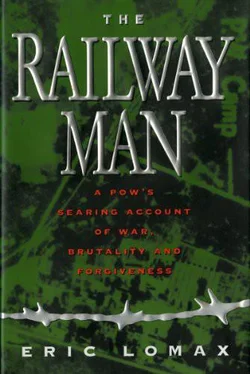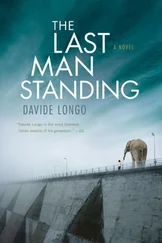Eric Lomax - The Railway Man
Здесь есть возможность читать онлайн «Eric Lomax - The Railway Man» весь текст электронной книги совершенно бесплатно (целиком полную версию без сокращений). В некоторых случаях можно слушать аудио, скачать через торрент в формате fb2 и присутствует краткое содержание. Город: New York, Год выпуска: 1995, ISBN: 1995, Издательство: W.W. Norton & Company, Жанр: Биографии и Мемуары, nonf_military, на английском языке. Описание произведения, (предисловие) а так же отзывы посетителей доступны на портале библиотеки ЛибКат.
- Название:The Railway Man
- Автор:
- Издательство:W.W. Norton & Company
- Жанр:
- Год:1995
- Город:New York
- ISBN:0393039102
- Рейтинг книги:4 / 5. Голосов: 1
-
Избранное:Добавить в избранное
- Отзывы:
-
Ваша оценка:
- 80
- 1
- 2
- 3
- 4
- 5
The Railway Man: краткое содержание, описание и аннотация
Предлагаем к чтению аннотацию, описание, краткое содержание или предисловие (зависит от того, что написал сам автор книги «The Railway Man»). Если вы не нашли необходимую информацию о книге — напишите в комментариях, мы постараемся отыскать её.
is a powerful tale of survival and of the human capacity to understand even those who have done us unthinkable harm.
The Railway Man — читать онлайн бесплатно полную книгу (весь текст) целиком
Ниже представлен текст книги, разбитый по страницам. Система сохранения места последней прочитанной страницы, позволяет с удобством читать онлайн бесплатно книгу «The Railway Man», без необходимости каждый раз заново искать на чём Вы остановились. Поставьте закладку, и сможете в любой момент перейти на страницу, на которой закончили чтение.
Интервал:
Закладка:
I was looking into Portobello Goods Yard, one of the largest and busiest rail freight yards in the country. It wasn’t empty even on that quiet late summer evening. There were two steam engines working near the bridge, shunting engines pushing trains and empty independent wagons further back into the yard. I read the engine numbers: 9387 and 9388. They were solid machines, their lines unflattering, with large tanks flanking and obscuring the curve of the boiler, but they were gorgeous. Each had a tall chimney, shaped like the stove-pipe hat worn by Isambard Kingdom Brunei as he posed against the giant paddle wheel of his Great Eastern for that famous photograph. I was not surprised he looked so confident, if he could create machines like these. Their six driving wheels turned slowly but irresistibly against the tons of rolling-stock in front of them; I heard the crash of straining metal as the couplings took the weight and tension; I smelled again the combination of hot oil and coal smoke that I remembered from my visit to the engine room of the Shetland steamer. A grey column of smoke billowed gently out of the chimney of the squat shunting engine, with little feathers of steam drifting back over the length of the tubular boiler and around the polished brass safety valves in their dome like a fixed bell set in front of the cab. I didn’t know it at the time, but I was watching a well-run engine in the hands of a good driver.
On the bridge, I felt suspended amidst the working engines, the branching rails and signal gantries, the station platforms and the brick warehouses. Anyone who has not seen a great railway junction on a sunny evening in the steam age cannot imagine the fascination of it. For a boy – for me – it was an animated, mysterious, mechanical paradise.
Further back in the yard several larger, more powerful-looking engines were drawn up, their giant spoked wheels connected by coupling rods that looked as big as the foot-bridge’s girders. There was an awesome potential in those linked wheels, rods and pistons – power at rest. A little way beyond Portobello one of the engines was drawn up beside a blackened wooden shed, and from a high door in its side a wooden chute hung out over the tender behind the engine. A man wearing a waistcoat and cloth cap was filling the chute from a big bucket of coal, and the lumps clattered down on to the black heaps which another man, dressed in a rough blackened grey jacket was shovelling and levelling into place.
That was the start of my incurable interest in railways. From that day onwards I spent a lot of time on Park Bridge, and soon became aware of other boys with similar interests leaning out over the engines as they slowed down on their way into the goods yard, or cruised at speed further out on their way up the East Coast main line between Edinburgh and London. For Edinburgh was a rail centre, and I lived at the eastern end of a great loop of lines punctuated by stations, depots, tunnels, repair yards and goods terminals. I could watch the flagship engines of the London and North Eastern Railway rush by, a long procession of carriages drawn after them as they headed for Edinburgh Waverley-the company’s very own station and a mecca for train lovers – or catch the smaller, older engines at the head of suburban and country trains. They were all trains, and that was enough for now.
It was like love, my fascination for those huge, noisy machines that were already near the end of their golden age. They moved with such magnificent purpose. They were alive, they had steam, smoke and the smell of minerals; they burned energy without concealment, and you could see their fire. They raced against themselves, losing more heat than they used, running by burning their own cargo of coal; but there was something very human about the need to keep fire going by hand, shovelling and watching, never for a second being able to forget responsibility for the journey and the work. Their waste didn’t have to be buried in lead-lined coffins, it was exhaled as carbon, sulphur and nitrogen, or swept and scattered as ash, the unburnt particles of coal settling gently on our clothes and hair.
Some things that humans make transcend their function; instruments can be magical. That explosive, rhythmic sound we call puffing says more to us about getting under way, about departure, than a petrol-driven snarl can ever do; perhaps it has something close to the beat of our pulse. Even if we were using up and heating the earth too much, and no-one knew that at the time, it would have been worth making an exception for steam engines. They were beautiful machines; the most beautiful machines produced in the industrial revolution.
The Reverend Awdry, author of the railway series of children’s books that attracted millions of infant readers long after their parents had forgotten the age of steam, once said that railways ‘touch’ people, make us seem eccentric; and yet we discover that they have the same effect on almost everybody else. I have certainly felt a little eccentric at times; but I suspect that we are all railway lovers, at some deep level.
The honest power of a steam engine is overwhelming-most of its important parts are on display. You see the great cylinder with cranks and mechanisms outside it, you see the ingenious connection of levers and rods to the enormous wheels and you have already understood that this combination of things will work, and you might even see how. Unlike a motor car or a nuclear ship, there’s no secrecy about a steam engine’s force. What engineers call the ‘motion’, the linked shafts and pistons and wheels that drive the engine, is as fascinating as the movement of a watch. And almost as jewel-like, for the couplings and connecting rods were often still chipped and filed smooth by hammer and chisel, after they came off the milling machine. Hands still made parts of these engines, and it is no surprise that drivers spoke of them as individuals. But essentially, the engine was a boiler held in heavy frames on a set of steel wheels.
The simplicity of it fascinated me. Coal burnt in a furnace surrounded by water created steam; steam confined in a cylinder pushed a piston, and linked to wheels by rods that turned the straight thrust of the piston into rotatory motion, the engine moved and worked. The idea that hordes of people and commodities could be carried at such shakingly powerful speeds by a sort of articulated kettle, in which the water could never be allowed to fall below the top of the furnace or there would be an explosion, seemed amazing to me. What made it all so different from today’s electric railways, which run at set speeds, was the need to be aware at every moment of the perilous balance of fire and water, which also gave the possibility of going a little faster if the engineman was good, or of disaster if he was incompetent.
Like everything else we make – like firearms, for example – the simple idea could be endlessly refined, developed and decorated. I discovered trains in their heyday, when steam under pressure had achieved astonishing things. Libraries of books were written on the improvement of Watt’s basic idea. More sophisticated valve gears gave more subtle control of pressure; steam could be superheated to get more pressure out of it; more yards could be added to the labyrinth of copper firetubes inside the boiler to give a bigger heating area, and therefore more heat and steam. But it was the way it all worked together that mattered, in the poetry of great engines, their appearance, speed and mystique.
I learned to distinguish machines, to love some more than others. There were, for example, the imposing Atlantic engines, the most powerful Scottish engines of the early century, their four big driving wheels half hidden by ‘splashers’, like great mudguards, and their lesser wheels chunky with thick spokes. One of these engines, up close, seemed monstrous, the vast tube of the boiler painted a solid dark green, the front a glossy black, resting on its 20-foot long iron frames. One of the driving wheels would dwarf a boy, who might come a little higher than the silver boss at the centre of its ring of black-painted spokes. The linked piston rods were as massive as one of the rails on which the wheels they drove ran so heavily. The rocking levers of the outside valves looked like swimmers’ arms frozen in mid stroke. Above were the pipes, flues and stanchions of polished brass and copper running the length of the boiler, and higher up still the top-hat of the chimney.
Читать дальшеИнтервал:
Закладка:
Похожие книги на «The Railway Man»
Представляем Вашему вниманию похожие книги на «The Railway Man» списком для выбора. Мы отобрали схожую по названию и смыслу литературу в надежде предоставить читателям больше вариантов отыскать новые, интересные, ещё непрочитанные произведения.
Обсуждение, отзывы о книге «The Railway Man» и просто собственные мнения читателей. Оставьте ваши комментарии, напишите, что Вы думаете о произведении, его смысле или главных героях. Укажите что конкретно понравилось, а что нет, и почему Вы так считаете.












